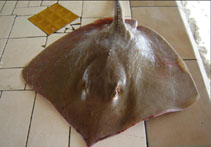| Family: |
Dasyatidae (Stingrays), subfamily: Dasyatinae |
| Max. size: |
200 cm WD (male/unsexed) |
| Environment: |
demersal; marine; depth range 1 - 36 m |
| Distribution: |
Western Atlantic: southern Gulf of Mexico and West Indies to Santos, Brazil. |
| Diagnosis: |
Disc rhomboid. Blunt and close-set tubercles that clothe the midzone of disc. Snout in front of eyes about 1.4 times as long as distance between outer margins of orbits. Upper surface brown, sometimes yellowish or olivaceous. Lower surface pure or yellowish white, ventral tail fold and dorsal keel black (Ref. 6902). |
| Biology: |
Demersal species on continental shelf to at least 35 m (but likely to be deeper); also found in brackish water, with young collected from tide pools (Ref. 114953). Mobile invertebrate feeders, feeds on benthic mobile invertebrates such as molluscs, crustaceans and worms associated with hard or nearby unconsolidated substrate (Ref. 103985); also on small fishes (Ref. 114953). Ovoviviparous (Ref. 50449). Marketed salted; also used in the preparation of gelatin and good quality oil. Between 1995 and 2000, at least 5 specimens have been traded as aquarium fish at Ceará, Brazil (Ref. 49392). |
| IUCN Red List Status: |
Near Threatened (NT); Date assessed: 21 June 2019 (A2d) Ref. (130435)
|
| Threat to humans: |
traumatogenic |
Source and more info: www.fishbase.org. For personal, classroom, and other internal use only. Not for publication.

